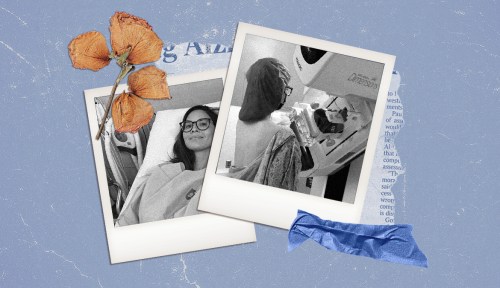The chances you know someone who’s had or currently has breast cancer is decently, and unfortunately, high. In fact, the average risk of a person developing breast cancer in the U.S. is about 13 percent, or a 1 in 8 chance, according to the American Cancer Society. Last week, actress Olivia Munn, 43, revealed she is a part of that growing statistic—and that she found out by using a breast cancer risk calculator.
Experts in This Article
surgical oncologist at Bedford Breast Center
breast medical oncologist at NYU Langone Health’s Perlmutter Cancer Center and clinical professor of Medicine at NYU Grossman School of Medicine
Despite having a “normal” mammogram just two months prior and testing negative for any BRCA gene mutations (which greatly increase your risk of breast cancer), she was recently diagnosed with Luminal B cancer in both breasts (an aggressive and fast-moving type), and swiftly underwent four surgeries—including a double mastectomy.
In her Instagram post announcing her diagnosis, Munn calls herself “lucky” and credits her OB/GYN, Thaïs Aliabadi, MD, for “saving her life” through early detection via a Breast Cancer Risk Assessment Score. After Munn received a “37 percent lifetime risk” of developing breast cancer through the assessment, her doctor sent her for further testing, which led to her diagnosis.
But while this assessment played a crucial role in The Newsroom star’s diagnosis, is it an accurate diagnostic tool for everyone? And what does a “lifetime risk” score really mean? Here are the top things to know about using a breast cancer risk calculator.
1. It takes two minutes to get your score
It’s not clear from Munn’s post which tool her doctor used to assess her risk, but the most widely used tool of this kind in the U.S. is the National Cancer Institute (NCI)’s Breast Cancer Risk Assessment Tool (also known as The Gail Model). This tool was developed in 1989 by Mitchell Gail, MD, and his colleagues at the NCI. The motivation behind the model was to provide health care professionals with a standardized method for testing a person’s risk of developing breast cancer—typically for the next five years, and up to age 90.
“The model takes into consideration age, family history, prior breast biopsies, and also information about reproductive history,” says Ruth Oratz, MD, a breast medical oncologist at NYU Langone Health’s Perlmutter Cancer Center and clinical professor of medicine at NYU Grossman School of Medicine.
While the quiz only takes two minutes to complete and can be done at home through the NCI, it’s important to note the test is purely the first step to potential breast cancer detection—it’s not a diagnosis by any means. “If a patient finds she’s at an increased risk of breast cancer, she should discuss this with her physician so they can do a more detailed evaluation of her risk,” adds Dr. Oratz.
An alternative is the Tyrer-Cuzick Model—also known as the IBIS model—created by U.K. cancer researchers in the late ‘90s. While The Gail Model and Tyrer-Cuzick Model are comparable, their testing algorithms vary, meaning your results may vary between tests.
2. The average score is 12%
While you may think an overall score of 37 percent (like Munn’s) is not that high, it’s actually quite alarming, as the average person’s risk sits right around 12 percent.
“A score greater than 20 percent is determined to be high,” says Leslie Memsic, MD, FACS, surgical oncologist at Bedford Breast Center. “Women who are determined to be high-risk can be monitored more closely with imaging studies, or in some cases, be treated with medications or operations to minimize their risk,” she adds.
If you use the breast cancer risk calculator provided by the NCI and receive a score higher than 12 percent (or higher than 20 percent), let your doctor know.
3. The tool isn’t accurate for everyone
Before you rush to take the assessment online, it’s important to note that even though The Gail Model has been updated over the years, there are still various gaps and issues with the test that can leave some groups of people with inaccurate results. Some things to keep in mind include:
Women who aren’t white may be at a disadvantage
For starters, “[the assessment] may not be as accurate in women of color or other ethnicities, as it was developed predominately on non-Hispanic white women,” says Dr. Memsic.
Black women in particular are often at a disadvantage when using this tool—as research continues to show they tend to get breast cancer at an earlier age and have higher mortality rates, according to a January 2020 review in Advances in Experimental Medicine and Biology1. In the hope of closing this gap, a new tool, developed by the NCI specifically for Black women, was created in 2021.
It isn’t meant for people with mutated BRCA genes or those with breast cancer history
Women who test positive for the mutated BRCA1 or BRCA2 gene are deemed at higher risk of developing breast cancer compared to the general population. But “for these women, the assessment is not really accurate,” says Dr. Oratz. One reason is The Gail Method does not incorporate genetic factors such as BRCA mutations into its calculations.
Women with mutated BRCA genes, or those with a history of breast cancer, will automatically have a score considered “high.” If this is your situation, you should already have regular checkups with your doctor in place.
“A high-risk warrants closer monitoring (every six months versus annual exams), and consideration for MRI and possible chemo preventions,” adds Dr. Mesmic.
Testing only begins at age 35
While breast cancer more commonly develops in middle-aged and older women (the median age is 62, per the NCI), there are many cases where women are diagnosed under the age of 35. Yet most online assessments only start testing right at age 35.
Dr. Memsic says “risk assessments and breast exams should start for all women as early as possible.” If you’re not old enough for testing with online assessments, it’s important to “do regular self-breast exams and get professional exams annually, starting no later than age 30,” she adds.
And as far as mammograms go? The standing recommendation to start annual mammograms at age 40, if you have no risk factors, is also approved by Dr. Memsic. But for those at higher risk—like people with a family history of breast cancer or dense breast tissue—mammograms should start younger than 40.
If you don’t know your family history, your results may be inaccurate
Another disadvantage of these assessment models is that “they’re only as accurate as the information provided,” says Dr. Memsic. That means, if you don’t know your family’s history with breast cancer, you’re missing an essential piece of information that helps ensure the assessment’s accuracy.
“If there is a family history of breast cancer, the patient may be referred for genetic testing,” says Dr. Oratz. “This information may lend itself to a more specific evaluation of the patient’s risk of breast or even other types of cancer,” she adds.
If you don’t know much about your family’s health history, ask questions. Start a conversation with family members close to you, so you can better understand you own personal risk.
4. A high score doesn’t mean you’ll definitely get breast cancer
It’s important to remember that at-home breast cancer risk calculators are only a baseline of information, and often just the first step in the larger process of receiving a diagnosis (or before even booking an appointment with your doctor). So no—it doesn’t always mean you have breast cancer; there are other evaluations that need to take place.
“Women with elevated risk scores will not necessarily get cancer—nor are women who are gene-negative or have low scores absolutely protected from getting breast cancer,” says Dr. Memsic.
When to see your doctor about your breast cancer risk
There’s never a wrong time to get checked for cancer. Early evaluation and detection will help your chances of receiving proper care and overcoming the disease, so if you’re concerned, make an appointment.
“All women who notice a breast mass, redness, nipple discharge, or a change in breast size or shape should get in to their doctor as soon as possible, while still keeping in mind the vast majority of masses are benign,” says Dr. Memsic.
“Even if your concern is something like breast pain (which is common and not generally associated with cancer), there is never a wrong time to get a breast exam,” she adds. “I encourage all women to feel comfortable getting their breasts checked regularly.”
Yedjou, Clement G et al. “Health and Racial Disparity in Breast Cancer.” Advances in experimental medicine and biology vol. 1152 (2019): 31-49. doi:10.1007/978-3-030-20301-6_3
↩︎
Sign Up for Our Daily Newsletter
Get all the latest in wellness, trends, food, fitness, beauty, and more delivered right to your inbox.
Got it, you've been added to our email list.









